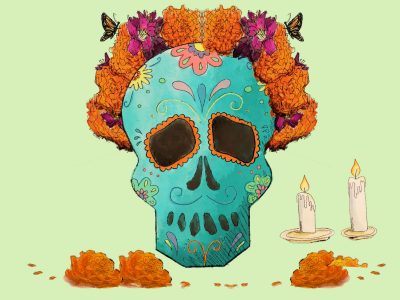While it might seem odd to want ghosts in your home, in my homeland, we welcome them with open arms.

Día de los Muertos, or the “Day of the Dead,” is a cultural celebration like no other. Contrary to popular belief, it’s not just the “Mexican version of Halloween,” but a time where the boundary between the living and the deceased becomes beautifully blurred, allowing us to remember and honor our loved ones who have passed away.
This holiday goes back three thousand years, when the Aztecs actually used to have a whole month dedicated to the dead instead of just a couple of days. They believed that death was not something to be feared, but rather should be welcomed as an integral part of life. The Aztec festival dedicated to Mictecacihuatl, the Lady of the Dead, celebrated the goddess of death and the afterlife. Now, Mexicans all over the world celebrate Día de los Muertos on Nov. 1 to Nov. 2, remembering their loved ones who have moved on to a better place.
Mexicans prepare for this celebration by creating “ofrendas” or altars in order to honor deceased family and friends.The ofrenda is a carefully arranged display that typically consists of several symbolic elements, each of which carries special meaning. Creating one is a deeply symbolic and personal act, and it serves as a way to welcome the spirits of the deceased back into the world of the living.
Here are some ways you can make your own ofrenda:
Photographs
One of the most important aspects is to include photographs of your deceased loved one, as it not only allows the living to remember them, it also welcomes the spirits back to the living world.
Marigolds
These bright orange flowers are not only beautiful, but their distinct color and smell is meant to help guide the spirits to the altar.
Candles
Candles are also meant to help guide the spirits to the altar, as well as offering them light. They are usually left in the form of a cross and also help represent one of the four elements: fire.
Water
A bowl of water is included to quench the thirst of the returning spirits, who are believed to have traveled a long way. This helps represent the element of water.
Pan de Muerto
Directly translating to, “Bread of the dead,” this sweet pastry is one of the most delicious things to come out of Mexico. It is placed on the ofrenda to nourish the dead as they make their way back to the land of the living, as well as for the living to enjoy during the celebration. They are usually decorated with a skull and crossbones, as well as representing the element of earth.
Incense
Not only does this purify the air and represent the element, but it is also placed to help carry the words and prayers of the living to the deceased in the afterlife.
Personal belongings
Place items loved or used by the deceased around their photo. The items can also be things that just remind you of them. Did they have an old watch they always wore? Maybe a special necklace? Here is where the most personalization occurs and you can truly connect with your loved one.
Food and drinks
Buy or make your deceased loved one’s favorite foods or drinks! Your loved one is coming back to share a meal with you, so place things you believe the dead and the living will enjoy!
All of these items are placed in tiers, and every state in Mexico has a different way of arranging their ofrendas.
The top tier represents who is being invited to the altar, as well as God and any holy figures. Typically, pictures and crosses are placed here.
The second tier is for food, drinks and the personal belongings of the deceased –– representing all the things they loved and cherished during their lifetime.
The third tier is for water, so spirits can quench their thirst before they make their way back to the afterlife. Flowers and candles should also be placed on this tier.
Día de los Muertos is a very special celebration for Mexicans, but it can be celebrated by anyone who wants to connect with a loved one who has passed away. The day is all about connecting with the dead –– but even more, it’s a day for the living to find comfort in knowing they will never be alone.
This beautiful tradition serves as a reminder that love and memories transcend the boundaries of life and death –– uniting people in a shared celebration that connects us to those we hold close to our hearts.














